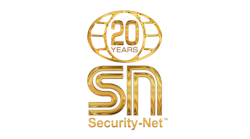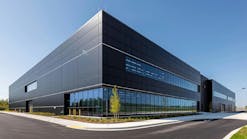This article originally appeared as the Cover Story in the October 2021 issue of Security Business magazine. When sharing, don’t forget to mention Security Business magazine on LinkedIn and @SecBusinessMag on Twitter.
While many people think of the security industry as being “recession-proof,” it certainly cannot be said that the market has been unaffected by COVID-19 and the stresses that the pandemic has placed on businesses around the globe. As nations began locking down in early 2020 to combat the rapid spread of the virus, many integrators experienced a small boon given that they were able to enter office buildings, schools and other facilities where the presence of people and power and network uptime requirements would have typically delayed installation projects.
However, as the pandemic has now worn into the latter part of 2021, the entire security ecosystem – product manufacturers, integrators and end-users – are beginning to feel the pain of global supply chain issues. What began with a lack of toilet paper on grocery store shelves that people largely laughed off has now worked its way into every sector of the economy, which includes critical components for products across the board.
Though most manufacturers are confident that challenges presented by the current lack of things like semiconductor chips will work themselves out over time, some are admitting that supply chain struggles are going to be an issue for the foreseeable future.
“The commercial backlog predominantly on the Americas business is double normal,” Dave Petratis, Chairman, President and CEO of access control manufacturer Allegion, said on a recent earnings call. “It is like someone turned on a light. We are doing a good job of processing that, but there are supply constraints, and it has resulted in a record backlog that I think we will continue to see.”
Abe Schwab, VP of New York-based systems integrator Care Security Systems, says the chipset shortage has impacted the availability of a wide range of security technologies, including surveillance cameras, power supplies, card readers, controllers and servers – all of which are required for most security projects. “Supply chain issues are impacting much of what we do,” Schwab says. “We have a pretty beefy lineup of both projects and personnel, but without goods to install, it is a bit of an issue. We need to have product in order to perform for our customers.”
Dave Sweeney, GM of Delaware-based integrator Advantech, says the biggest challenge his company is currently facing is simply availability – not only of security products themselves, but also accurate information pertaining to product availability and forecasting. “What seems to have evolved very rapidly is that product lead times have [extended] significantly,” he says. “Manufacturers are requiring forecasting and suggesting that if non-forecasted projects are ordered, they may not be delivered in a timely fashion.”
While long lead times and availability may be the primary challenges facing integrators as they navigate these uncharted waters, Eva Mach, President and CEO of Minnesota-based Pro-Tec Design, says the unpredictability of everything is what concerns her most. “Trying to get information is difficult,” she says. “We are staying as close as we can to our vendors and manufacturers, but some of them don’t have answers either. What I have been told and what I understand is that this will continue through the first quarter and possibly through the second quarter of next year.”
Coping Strategies
According to Henry Olivares, Founder and President of Arizona-based APL Access & Security, they initially started noticing product shortages in late spring but did not experience any issues with the manufacturers they were working with at the time. More recently though, his company has started to stock up on equipment that is suffering from production delays.
“We started getting smarter and we started buying stock parts, and we started ordering parts as soon as a job was approved instead of waiting until the job was ready,” Olivares explains.
Mach says Pro-Tec Design has also placed greater emphasis on stocking up on inventory of certain equipment; however, that is not feasible for all products. “We really focused on getting data, and we now have a weekly product forecast [that outlines] what is in our sales forecast and what our clients are going to need,” Mach says. “We recently hired a data analyst – not necessarily to predict product forecasts – but right now that is one our major areas of focus. How do we know what we need? How do we share it with our vendors and manufacturers in a timely manner so they can work with us?”
Sweeney says Advantech has changed its ordering process to account for products with longer lead times and is also leveraging its warehouse to stock and stage products for customers. Additionally, the company is also talking with customers about invoicing for stored materials. “That’s a relatively logical question that customers are usually ok with working with us on,” he says. “We follow whatever procedures they have in place, but the alternative is, if we can’t, then we may not be able to do a project within [the customer’s] timeline.”
Integrators are also having to substitute alternative products in many cases to ensure projects get completed on time. “If manufacturer A is not available, we look at what is available from manufacturer B and again, to communicate and educate our customers on what options are available for them so that they have a solution and not just a problem,” says Schwab of Care Security, adding that sometimes they are simply not able to just plug in a product from a rival manufacturer to fill a void.
If an end-user insists on having a product from a certain manufacturer, then Sweeney says they run the risk of having to push back their technology deployment indefinitely. He adds that it is also paramount that sales personnel understand they cannot promise things that a company in unable deliver or complete within a certain timeframe.
On a positive note, Schwab says most of their customers are understanding of these supply chain issues because many of them are suffering through the same challenges; however, he adds that they are having end-users provide them with orders so that they can stage equipment as soon as possible.
“Whereas in the past we would wait to order the equipment until the phase that it is required, now we are ordering that equipment straight up and we will stage it for them,” Schwab says. “This way, we have the best chance of getting it as soon as possible.”
Additionally, Schwab says they are using their leverage with manufacturers in some circumstances to ensure they are at the front of the line. “We speak to a manufacturer and let them know we have a Fortune 500 customer that needs to get a project completed,” he says. “When they know who that customer is and they understand the value of that customer, they [sometimes] understand how important it is to get that equipment prioritized so that they are not holding up the project. They need to understand the business value of making sure that equipment is there for them.”
Ancillary Supply Chain Struggles
In addition to a lack of security devices, many integrators are also having trouble procuring some of the basic tools necessary to run their businesses. This is perhaps being hardest felt by integrators who need to purchase new fleet vehicles – many of which will not be delivered until later this year or even early 2022 due to the ongoing chip shortage.
Schwab says Care Security Systems recently submitted an order for several new fleet vehicles, but they were told they would not be likely receive any of them until October at the earliest. One way to address this issue, Schwab says, is by delaying the recycling of vehicles as much as possible.
“If we had a vehicle that was end of life a year ago or two ago, we would have traded that up for a new vehicle,” he says. “We are trying to hold on to those longer now to push off the need for that new vehicle, which is more difficult to come by. The same goes for heavy equipment, like lifts and other things we use, which we are trying to keep longer so that we do not have the same supply chain issues on new equipment the needs to be ordered.”
Beyond fleet vehicles, Sweeney says this has even trickled down to other common tools that technicians use daily – for example, he recently ordered an A-frame ladder because a lift was unavailable, but it would not be in stock for 20 weeks.
Olivares says APL Access & Security has also had to turn to places like Amazon to stock up on things like high-end video cards that power video wall displays, since they are out of stock for most suppliers within the traditional security channel. “As soon as we see that Amazon has them, we kind of clean them out,” he admits.
A Perfect Storm
While the cause of the industry’s product shortages is primarily rooted in the pandemic, the fact is a confluence of factors have come together to create a perfect storm of supply chain woes. COVID-19 may have forced factories to close due to a shortage of workers; however, demand never decreased – and because there are not as many truck drivers on the road as there used to be, shipments became backed up at ports. Combine that with a lack of warehouse workers to ship products for delivery and you have a chain reaction that industries across the board have yet to fully recover from.
“I think it is fair to say that it is a pretty holistic workforce shortage in key sectors that is impacting the ability of products to be manufactured and delivered,” Sweeney says. “Everyone I have spoken to has been very vague on when they feel like it is going to get better, but all of the vague answers end with 2022. We have a little while yet, which is what gives me some anxiety for sure.”
Mach says labor shortages at the nation’s ports and related news are not issues she would have paid much attention to several years ago, but now they have become a significant threat to the industry. “Those things were not on my radar, but now I’m reading IndustryWeek and everything that I can to get an idea of what is happening economy-wide, not just the security industry,” she adds.
If they cannot obtain a certain product, Mach says they also run the risk of losing business because an end-user may have money in their budget or from a grant that must be spent within a certain length of time. “Communication is essential,” she says. “Internally, this has caused quite a bit of disruption because we are spending so much time on gathering information and communicating internally and externally – that is time that could be spent doing something else. So far, we have been able to handle things, but six months, nine months – that is a long time to be dealing with this issue.”
In the future, Schwab believes many of the struggles that integrators are going through relative to the supply chain could be alleviated if the industry did not outsource so many crucial components to overseas vendors.
“The supply chain needs to look at diversifying and sourcing the materials from local manufacturers and having diversified suppliers so that they are not relying on one or two suppliers in the event that they are not able to provide what they need,” Schwab says. “Also, they need to look at keeping supply of inventory in stock so that they are prepared to project a quarter or even a year ahead in advance, so they are not left in the hole.”
Joel Griffin is Editor-in-Chief of SecurityInfoWatch.com. All of the integrators quoted in this article are members of Security-Net group of integrators. Learn more at www.security-net.com.


!['[Lack of product availability] is really across the industry, and the folks that are able to deliver in a timely fashion are tacking on COVID surcharges, air freight fees and additional expenses we had not planned for.' Dave Sweeney, Advantech '[Lack of product availability] is really across the industry, and the folks that are able to deliver in a timely fashion are tacking on COVID surcharges, air freight fees and additional expenses we had not planned for.' Dave Sweeney, Advantech](https://img.securityinfowatch.com/files/base/cygnus/siw/image/2021/09/Dave_Sweeney.6148c4a312de4.png?auto=format,compress&fit=max&q=45&w=250&width=250)


![“We really focused on getting data, and we now have a weekly product forecast [that outlines] what is in our sales forecast and what our clients are going to need.' - Eva Mach, Pro-Tec Design “We really focused on getting data, and we now have a weekly product forecast [that outlines] what is in our sales forecast and what our clients are going to need.' - Eva Mach, Pro-Tec Design](https://img.securityinfowatch.com/files/base/cygnus/siw/image/2021/09/Mach__Eva.6148c4a31dd1a.png?auto=format,compress&fit=max&q=45&w=250&width=250)





